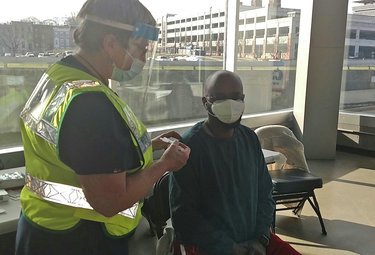County starts giving COVID vaccines as hospitalizations break another record
— Photo from the office of Albany County Executive Daniel McCoy
A shot in the arm: Albany County started giving COVID-19 vaccinations on Thursday at a POD, or point of dispensing, set up in the Times Union Center in Albany. Only people in the first tier, 1a, primarily health-care workers, are eligible.
ALBANY COUNTY — Hundreds of Albany County residents were vaccinated against COVID-19 on Thursday — the first to get shots from the county’s health department.
The shots were administered from the department’s POD, or point of dispensing, at the Times Union Center in Albany.
Also on Thursday, Albany County Executive Daniel McCoy announced another broken record for hospitalizations — 163 county residents are currently hospitalized with the virus — and another death. A man in his nineties died of the disease on Wednesday, bringing the county’s COVID-19 death toll to 240.
Governor Andrew Cuomo, in his Thursday press briefing, said he had spoken with local government leaders who are worried about the highly transmissible variant of COVID-19 from the United Kingdom.
In an update on Thursday, the Centers for Disease Control and Prevention reported 52 cases of the variant, known as B.1.1.7, in the United States with 26 cases in California, 22 in Florida, two in Colorado, and one case each in Georgia and New York.
“In the U.K., it overtook everything in three weeks. Local governments as well as I am very concerned about the local hospital capacity,” said Cuomo. “We are continuing to see an increase in the hospitalization rate and the red line is overwhelming the hospital system.
“That’s where California is, that’s where other states are. If the UK spread catches on in New York, hospitalization rate goes up, the hospital staff is sick, then we have a real problem, and then we’re at shutdown again.”
While New York has a plan for increasing hospital bed capacity and, unlike in the spring, has set aside enough equipment, Cuomo said, “The primary problem in hospital capacity now is staff shortage.”
He stressed the importance, then, of getting health-care workers vaccinated promptly; they are in the first tier, 1a, of people to receive a COVID-19 vaccine.
According to the CDC website, New York State, as of Thursday night, has received 1,134,800 doses of vaccine and has administered 353,788 shots.
Cuomo said that, statewide, the original rate of 10,000 vaccinations each day had increased on Monday to 30,000, and on Thursday was “in excess of 50,000.”
Supply is currently a limiting factor.
“In total, we have 2 million health-care workers in the state,” said Cuomo. “In total, we only have 900,000 doses for the 2 million.”
Cuomo admonished New York City, which has 917,000 eligible health-care workers in tier 1a but has administered just 144,000 vaccines, roughly 14 percent of the health-care workers.
Since December, New York City has received 304,000 doses of vaccine and administered less than half, according to a statement from Peter Ajemian, a spokesman for the state’s health department.
Once people in the first tier are vaccinated, essential workers — like police, firefighters, and teachers — will be vaccinated as part of 1b. That tier also includes residents who are 75 or older.
“When we got to 1b, some local governments said they want to prioritize police,” Cuomo said during his Thursday briefing. “They can’t do that. First, some local governments have said, ‘Well police are health-care workers because police give CPR’ … Every police officer is trained to do CPR. That doesn't make every police officer a health-care worker. That's just silly.”
Local governments are being asked to coordinate with unions to see if they can “self-administer” shots to their members.
Cuomo concluded of those in the 1b tier, “It is one group and they’re going to be treated fairly and I’m not going to pick police over teachers, over firefighters, over grandpa and grandma and mom in my case at 75-plus. That just will not be allowed, period.”
Newest numbers
As of Thursday morning, Albany County has had 13,215 confirmed cases of COVID-19 with 283 new cases reported since Wednesday, according to a release from McCoy’s office.
Of the new cases, 235 did not have a clear source of infection identified, 38 had close contact with someone infected with the disease, nine are health-care workers or residents of congregate settings, and one had traveled.
The five-day average for new daily positives has decreased to 239.4 from 242.8. There are now 1,822 active cases in the county, up from 1,781 yesterday.
The number of county residents under quarantine increased to 2,902 from 2,898. So far, 41,401 residents have completed quarantine. Of those 11,393 had tested positive and recovered. That is an increase of 230 recoveries since Wednesday.
There were 20 new hospitalizations overnight, and there are 163 county residents currently hospitalized from the virus. There are now 19 patients in intensive-care units, one more than on Wednesday.
Of the state’s 10 regions, according to a Thursday release from the governor’s office, the Capital Region continues to have the worst rate for available ICU beds, at 17 percent. Currently, 207 of the region’s 252 ICU beds are filled. Statewide, 28 percent of ICU beds are available.
For the first time, the percentage of Capital Region residents hospitalized with COVID-19 went over 0.04 percent to 0.05 percent. The region has 489 residents hospitalized with the disease, leaving 24 percent of its beds available; 27 percent could be available under a seven-day surge plan.
Statewide, 0.04 percent of New Yorkersare hospitalized with the disease, leaving 29 percent of the state’s hospital beds available.
The Capital Region’s infection rate, as a seven-day average, is 10.04 percent. Statewide, the positivity rate is 7.85 percent.
The seven-day rolling average for Albany County, according to the state’s dashboard as of Jan. 6, is 10.2 percent.


